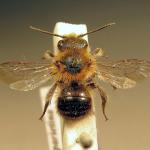Osmia angustula ZETTERSTEDT 1838; Osmia globosa CRESSON 1864 (nec. SCOPOLI 1763); Osmia vulpecula GERSTÄCKER 1869; Osmia globosiformis COCKERELL 1910
In the past, this bee was sometimes misidentified as O. parietina or O. uncinata.
Rare. Restricted to the central Scottish Highlands (Else & Edwards, 1996).
Listed as Vulnerable (RDB2) in Shirt (1987) and Falk (1991).
Habitat characteristically consists of exposed, base-rich uplands (about 260-430 m). A site for this species near Blair Atholl, Tayside, was visited several times by M Edwards and G R Else in the early 1980s. It comprised exposed sheep pasture on low, dry hillocks on a south-facing mica-schist escarpment. Vegetation was heavily-grazed heather, with lichen and moss predominating amongst it. Possible forage plants utilised by the bee there included bird's-foot-trefoil (Lotus corniculatus), bugle (Ajuga reptans) and bilberry (Vaccinium myrtillus).
Late May to the end of July. Single-brooded.
Females of this bee build clusters of oval cells from masticated leaf pulp on the undersides of rocks overlying shallow depressions. When freshly constructed the cells are probably bright green but, with time, assume a dull brown colour and then closely resemble rabbit droppings. The number of cells per rock varies from one to about 230, but large numbers either result from several females working independently of each other in a single season, or from several generations of females. Rearings from nests collected at the Blair Atholl site mentioned above suggest that in Britain this bee has a minimum two-year life cycle, the first winter being passed as a prepupa, the second as a diapausing adult within its cocoon. Some individuals may emerge from their nests three or four years after their cells were sealed (see Smith, 1851b). Such a staggered emergence could be important in northern Britain, where prolonged, inclement early summer weather could seriously hinder the activity of this bee.
With the exception of the forage species reported above, there are apparently no British records. It is probably polylectic, as in Germany (Westrich, 1989).
The chrysidid wasp Chrysura hirsuta has been reared from Scottish nests. The larva of the parasitoid attacks the host larva after the latter has spun its tough cocoon. When fully grown the C. hirsuta larva spins its own cocoon within that of the host (see drawing in Morgan, 1984). The chrysidid seems to have an obligate, minimum, two-year life cycle which parallels that of its host (Else & Edwards, 1996).
Profile written: 1998
Proofed: February 2012


